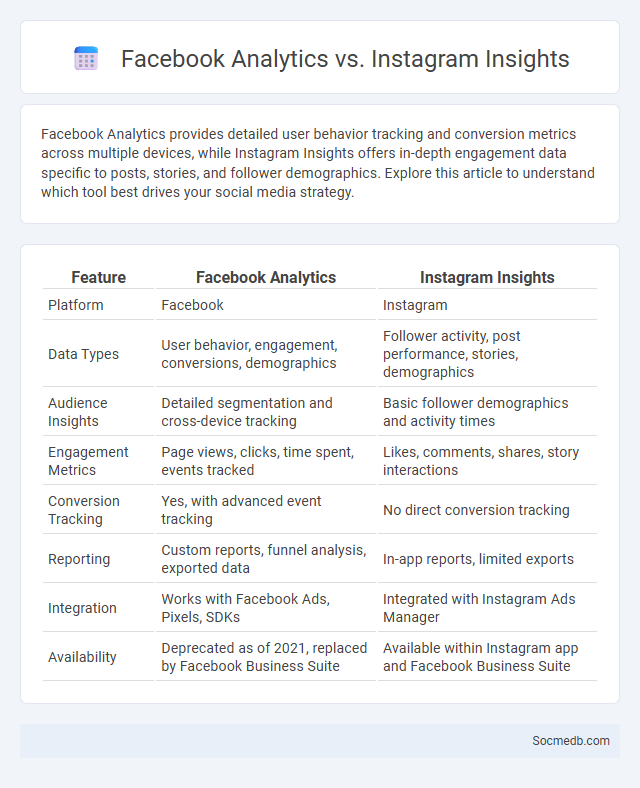
Photo illustration: Facebook Analytics vs Instagram Insights
Facebook Analytics provides detailed user behavior tracking and conversion metrics across multiple devices, while Instagram Insights offers in-depth engagement data specific to posts, stories, and follower demographics. Explore this article to understand which tool best drives your social media strategy.
Table of Comparison
| Feature | Facebook Analytics | Instagram Insights |
|---|---|---|
| Platform | ||
| Data Types | User behavior, engagement, conversions, demographics | Follower activity, post performance, stories, demographics |
| Audience Insights | Detailed segmentation and cross-device tracking | Basic follower demographics and activity times |
| Engagement Metrics | Page views, clicks, time spent, events tracked | Likes, comments, shares, story interactions |
| Conversion Tracking | Yes, with advanced event tracking | No direct conversion tracking |
| Reporting | Custom reports, funnel analysis, exported data | In-app reports, limited exports |
| Integration | Works with Facebook Ads, Pixels, SDKs | Integrated with Instagram Ads Manager |
| Availability | Deprecated as of 2021, replaced by Facebook Business Suite | Available within Instagram app and Facebook Business Suite |
Introduction to Social Media Analytics
Social media analytics involves the systematic collection and analysis of data from social media platforms like Facebook, Twitter, and Instagram to understand user behavior and sentiment. Techniques such as sentiment analysis, engagement metrics tracking, and influencer identification enable businesses to optimize marketing strategies and improve customer targeting. Leveraging tools like Hootsuite Insights and Brandwatch enhances real-time decision-making by providing actionable insights into trends, demographics, and competitive performance.
Overview of Facebook Analytics
Facebook Analytics provides comprehensive insights into user behavior, engagement, and conversion metrics across your Facebook pages and apps. It tracks key performance indicators such as page views, post reach, audience demographics, and user interactions to help optimize content strategy. By leveraging these data-driven insights, you can improve Your social media marketing efforts and measure the effectiveness of your campaigns accurately.
Exploring Instagram Insights
Instagram Insights offers detailed analytics on your audience demographics, engagement rates, and content performance, helping you understand what resonates with your followers. By analyzing reach, impressions, and profile visits, you can tailor your posts to maximize visibility and grow your brand effectively. Use these metrics regularly to refine your social media strategy and enhance your Instagram presence.
General Features of Analytics Tools
Social media analytics tools provide comprehensive insights by tracking metrics such as engagement rates, audience demographics, and content reach to optimize marketing strategies. These tools offer real-time data visualization and customizable reports, enabling businesses to monitor campaign performance and competitor analysis effectively. Advanced features often include sentiment analysis, influencer identification, and predictive analytics to enhance decision-making and boost social media ROI.
Key Metrics: Facebook Analytics vs Instagram Insights
Facebook Analytics provides in-depth key metrics such as user demographics, engagement rates, session duration, and conversion tracking, enabling precise analysis of audience behavior and campaign effectiveness. Instagram Insights focuses on metrics like follower growth, post reach, impressions, profile visits, and story interactions, optimizing content performance and audience engagement on the platform. Comparing both tools reveals that Facebook Analytics offers broader, multi-dimensional data ideal for detailed marketing strategies, while Instagram Insights delivers concise, visually-driven metrics tailored for content creators and brand engagement.
User Interface Comparison
Social media platforms differ significantly in user interface design, impacting user engagement and ease of navigation. Instagram prioritizes visual content with a minimalist feed and streamlined story features, while Facebook offers a more complex interface with diverse functionalities such as groups, marketplaces, and detailed notifications. Twitter emphasizes real-time text updates with a clean timeline and trending topics sidebar, optimizing quick content consumption and interaction.
Data Visualization Capabilities
Social media platforms leverage advanced data visualization capabilities to transform complex datasets into intuitive graphs, heat maps, and interactive dashboards, enhancing user engagement and content strategy optimization. These visual tools enable marketers to track real-time performance metrics, audience demographics, and sentiment analysis efficiently across networks like Facebook, Instagram, and Twitter. Integration with AI-driven analytics further refines insights, facilitating data-driven decision-making and targeted campaign adjustments.
Reporting and Export Options
Social media platforms offer advanced reporting and export options that enable you to track engagement metrics, audience demographics, and content performance with precision. These tools provide downloadable reports in various formats such as CSV, PDF, and Excel, allowing seamless integration with other analytical software. Utilizing these features enhances your ability to make data-driven decisions and optimize your social media strategy effectively.
Integrations and Compatibility
Social media platforms offer extensive integrations and compatibility features that allow seamless connection with various apps, websites, and third-party tools, enhancing your online presence and engagement. APIs enable synchronization with marketing software, e-commerce systems, and content management platforms, supporting efficient data sharing and automated workflows. Ensuring compatibility with multiple devices and operating systems guarantees your social media strategies reach audiences across smartphones, tablets, and desktops without disruption.
Choosing the Right Analytics Tool for Your Business
Selecting the right social media analytics tool depends on your business goals, target audience, and platform compatibility. Tools like Sprout Social, Hootsuite Analytics, and Google Analytics offer comprehensive data on engagement rates, follower growth, and content performance. Accurate analytics enable informed decision-making, optimized marketing strategies, and improved return on investment.
 socmedb.com
socmedb.com